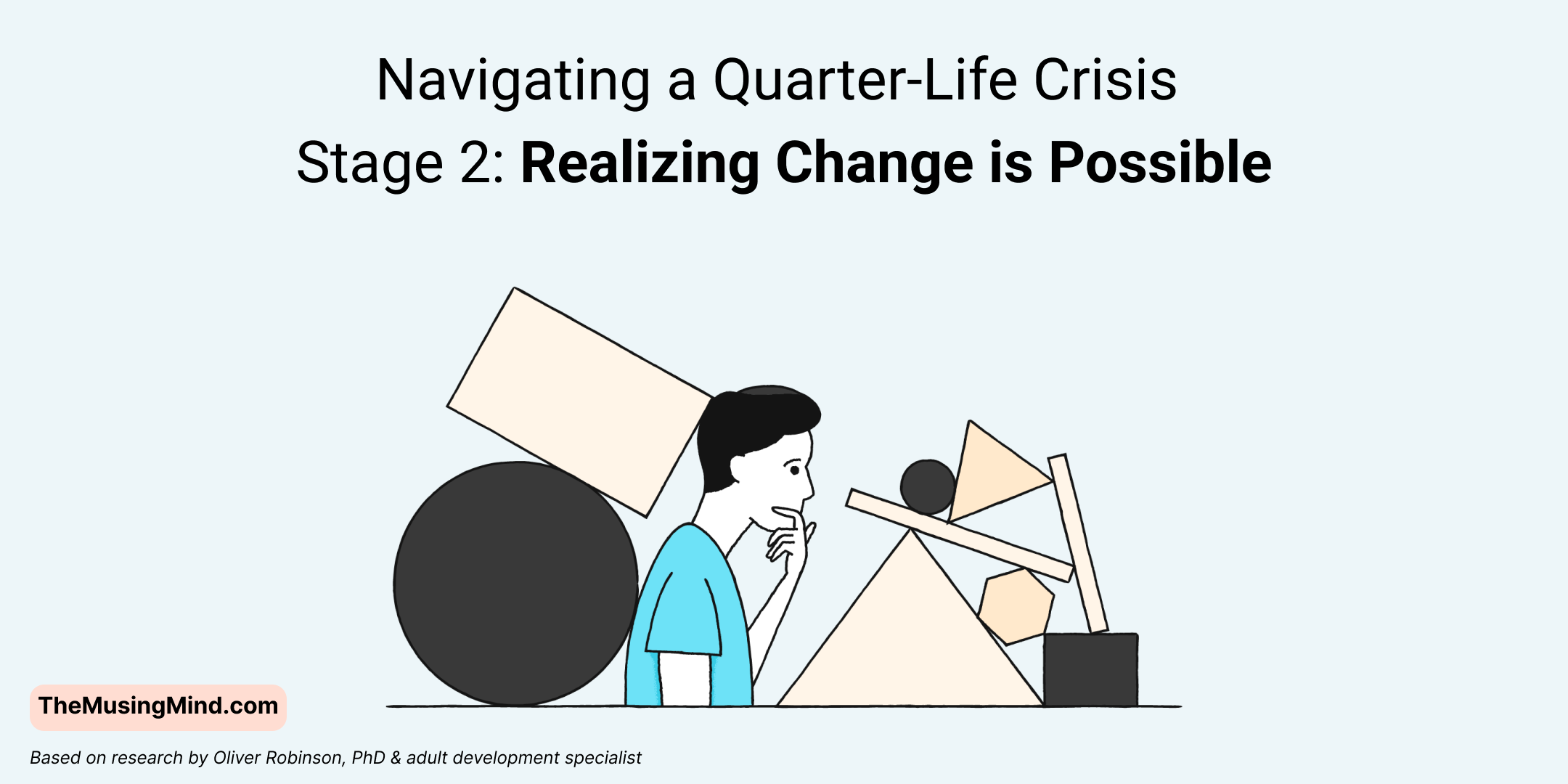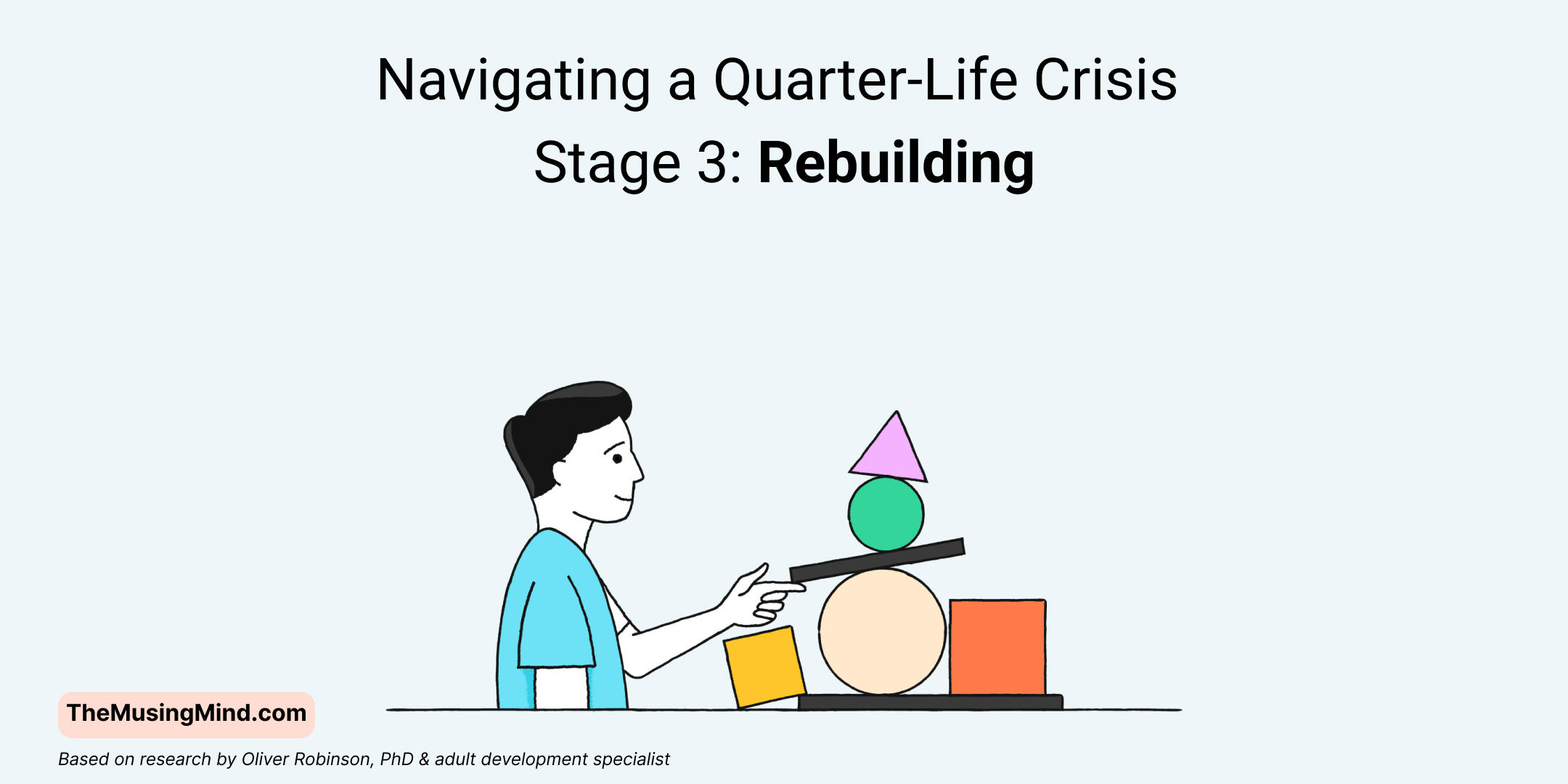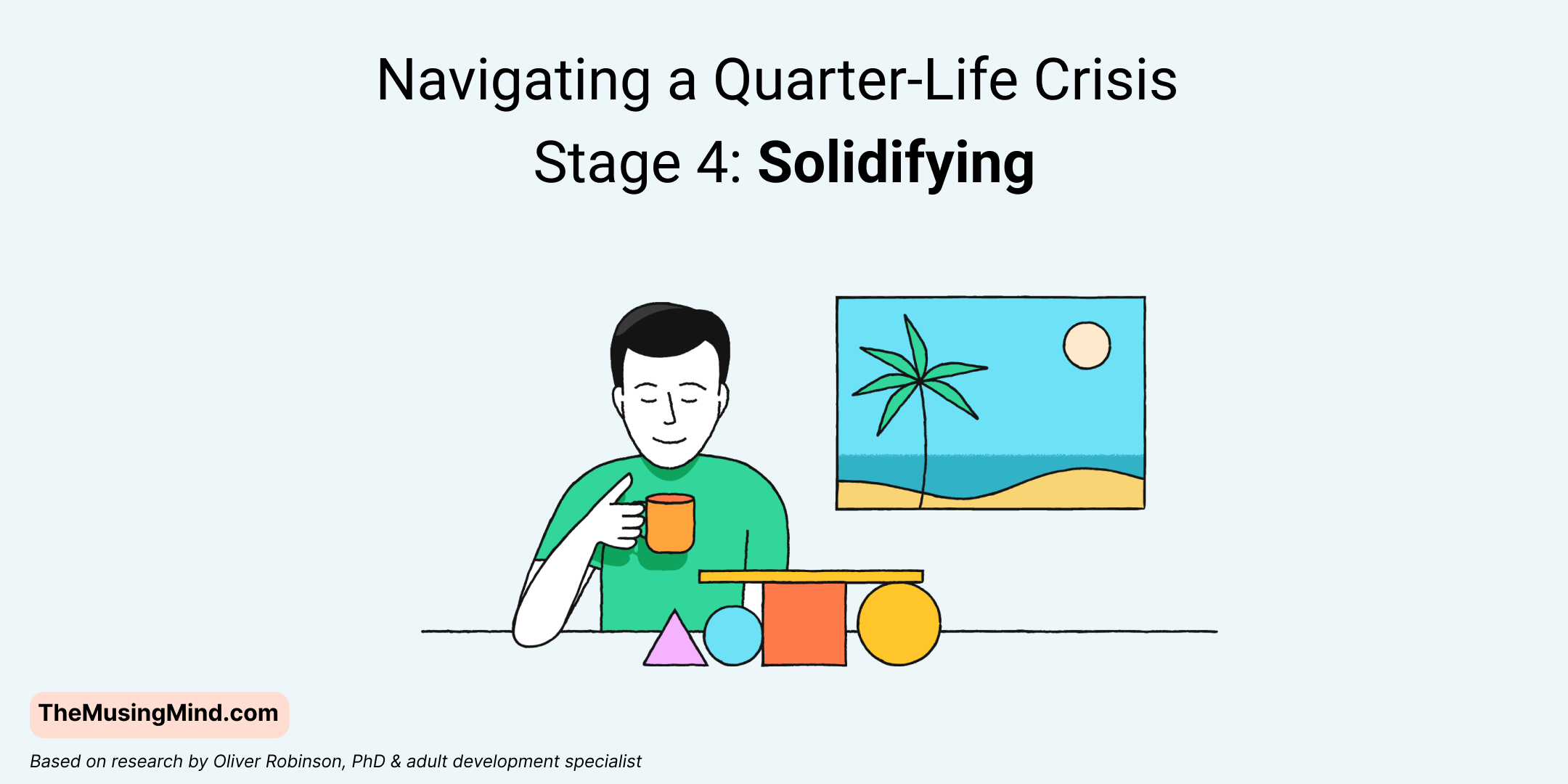Navigating a Quarter-Life Crisis in 4 Stages
Designs by Miguel Camacho
Other resources you may like:
Are you having a quarter-life crisis? Take the self-assessment
If you are between the ages of 25 and 35 and have been struggling for months on end with feelings of failure, doubt, depression, or anxiety — you may be in the midst of a Quarter-Life Crisis.
What is a Quarter-Life Crisis?
This article provides a more in-depth read of what it can feel like and what can cause it, but in brief, a Quarter-Life Crisis can include some of the following factors:
Feeling trapped and like something needs to change
Stress, demotivation, doubt, intense emotions, isolation
Instability, feeling all over the place, not feeling “normal”
Symptoms last for over 1 year and feel like they will last forever
Negativity is overwhelming. Struggling to cope with known strategies
Intense questioning of yourself, your life situation, and the meaning of life
The good news is that the Quarter-Life Crisis is actually a positive marker in the process of self-development. It is an opportunity to come more fully into one’s own life and sense of self, and to become more aligned with one’s deeper purpose in life and way of living.
How do you navigate a Quarter-Life Crisis?
The process will look different for each person, however there are 4 main stages that underly an individual’s passage through a Quarter-Life Crisis, based on the work of adult developmental researcher and professor, Dr Oliver Robinson. These 4 stages are as follows:
Stage 1: Feeling Trapped
Stage 2: Realizing Change is Possible
Stage 3: Rebuilding
Stage 4: Solidifying
Stage 1: Feeling Trapped
In the first stage, one feels an acute sense of being trapped in a commitment such as a job or relationship, or life situation. The desire for something else can become intense, as can the feeling of hopelessness and despair.
Stage 1 can be triggered by many different causes, but here are a few examples:
Experiencing a work burnout
Feeling stagnant in work or life, but being unsure of what to do next in life
Facing a big loss in life, such as the death of a loved one or the end of a romantic relationship
Negative comparisons about oneself vs one’s peer group or network, or a sense of falling behind or not achieving enough
Becoming disconnected from one’s support network and family as a result of people moving, becoming more busy, or starting relationships/families
The thoughts and feelings from stage 1 may lurk for a long time beneath the conscious surface (in the “shadow” self, as termed by psychoanalyst Carl Jung), causing intense disruptions at the conscious level before an individual even becomes aware of the reasons.
However, this period does not last forever. By becoming aware of these feelings and thoughts and looking for their source, one begins the process of transitioning into the next stage of navigating the Quarter-Life Crisis.
Use the following prompts to help you arrive at the realization and transition to stage 2:
Reflect on the past
Which values or beliefs from my parents and society influenced me growing up?
What external expectations have shaped my decisions?
Who have I had to be to survive until now?
Reflect on the present
Where does the self doubt and trapped feeling come from?
What parts of life drain my energy? Which fill my energy up?
Who do I want to be?
Reflect on the future
What values and beliefs do I aspire to live by?
What would I do if I were free from commitments and could start fresh?
Who can I be moving forward?
Stage 2: Realizing Change is Possible
While stage 1 may be the most intense stage, stage 2 is the most pivotal stage.
In this stage, it is important to do just as the title suggests: come to believe that you are capable of making changes to your life situation, in order to resolve the mental and emotional dissonance, and the feelings of being trapped.
Here, it is essential to gather the courage and the motivation to look beyond the negative and limiting self-narratives from stage 1 that will act as walls, preventing you from seeing that change is, in fact possible.
Such thought patterns can include:
It’s better to keep things as they are, rather than face the unknown
I have no choice but to stay in this situation
I’ve tried everything and nothing will help
I don’t know how/what to change
I’m just not capable of change
Without believing that there is a possibility for change, an individual will remain stuck in stage 1 and will not be able to move to stage 3.
It may be hard to believe in such a dark or discouraging period, but initiating change and progress is always possible, no matter the circumstances. The reflections in stage 1 are key to calling up the courage to see that change is possible, and the motivation enough to seek it out.
In stage 2, the task is to process your stage 1 reflections and come up with new wisdom:
What in my life no longer serves my growth and wellbeing? What needs to change?
How does who I really want to be differ from who I have been?
What do I really want out of life?
What might I start, stop, and continue doing?
Next, ideate on the possibilities for what change might look like. In this stage, focus more on being creative and expansive, rather than the specifics of possible changes or narrowing down your options.
Also, consider enlisting help from a friend/mentor/coach/therapist to brainstorm possible ideas.
Stage 3: Rebuilding
In this stage, you should begin to gather momentum and motivation to make some of the changes you have come up with.
This is the part of the process that demonstrates, by taking into account your life experiences, learning from them, and rebuilding your outlook on life in a way that aligns deeper with your aspirational values, desires, and beliefs.
In stage 3, you can begin to:
Prioritize your idea list. Review your list from stage 2 and flesh out your most appealing ideas. Also, be open to the possibility of accepting some aspects of life which serve other areas of life that are meaningful to you. Change is definitely a big part of navigating a QLC, but not everything needs to change.
Experiment and explore. Try new things, say yes to new opportunities, explore life, expand your horizons and gain exposure to a wider diversity of life. Be bold, curious, and follow your heart to discover how you truly want to live your life.
Stage 4: Solidifying
In stage 4, it is important to lock in the external changes that fit your life vision and internalize the mental changes that have occurred. It is also a time of solidifying the new structure of your life, to allow the new changes to become a permanent part of your life.
Return to a reflection-oriented mind space. Contemplate your answers to questions such as:
How did experimenting with changes go?
What did I learn?
What feels better?
What still feels off?
Who am I now?
Where is who I am now consistent now with who I was before?
What other changes may be needed?
Use some of the following methods to internalize your life learnings and life changes.
Develop a formal set of life lessons/wisdom from your experience, or create a life purpose statement
Make an accountability commitment to someone in your life that you trust. Promise to them to work stick with the changes and continue growing
Share your experiences and learnings with others through teaching, coaching, writing, art, or other means
Take a meaningful trip or create a ritual to honor of your process of transformation
Conduct an integration therapy or coaching session
When to change – and when not to change
In your navigation journey, be careful not to get caught up in changing everything.
Consider the following rules as a rule of thumb for when to make a change:
If some part of your life is actively harmful (manipulative, toxic, abusive, etc.) OR
Not aligned with your true values/belief system AND
Cannot be brought closer in alignment (through conversation, negotiation, compromise, planning, time, etc.) AND
Is not vital for another meaningful life element (e.g. a job’s income for your family)
There are many things in life that we don’t desire or enjoy (e.g. homework, boring tasks, changing diapers). Yet, they can be accepted in service of creating an overall fulfilling blend of life
Sometimes a change means coming to accept a life element for what it is, without seeking to change it.
A job can be a job without being deeply aligned
A relationship can have its ups and downs while still being worthwhile
Elements of any place of living can be appreciated
That’s all for today! Continue your journey to navigate your own Quarter-Life Crisis via this essay and explore the resources on this page.




